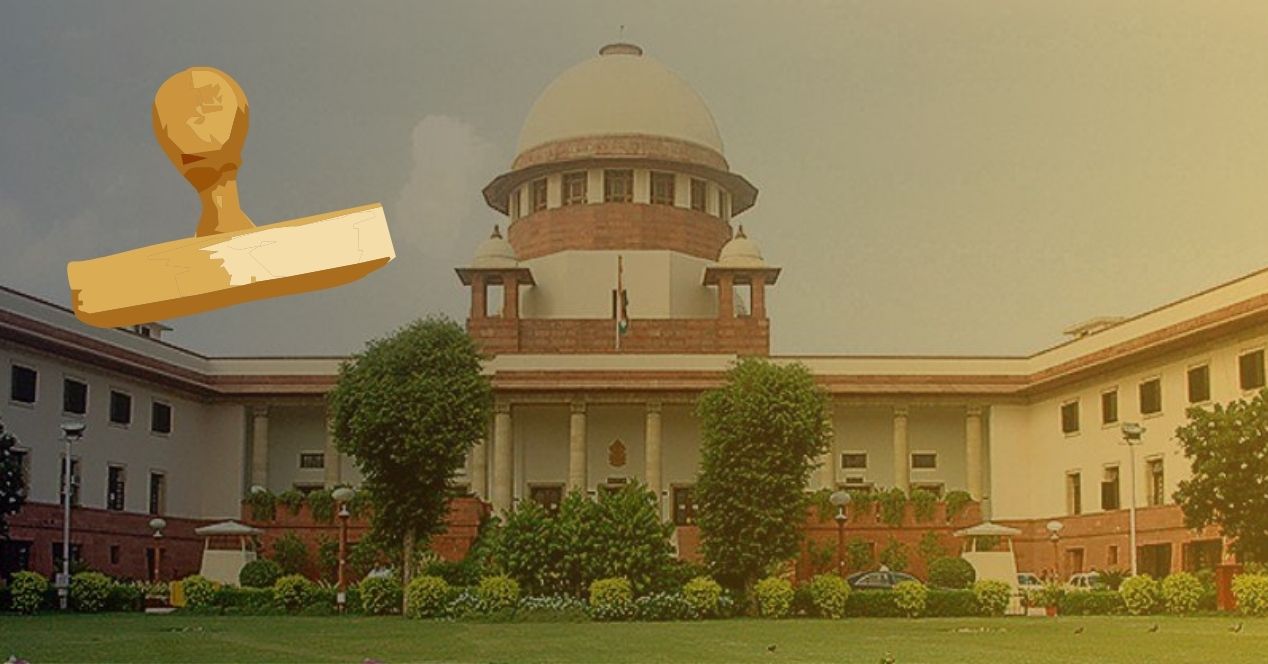Analysis
Validity of an Unstamped Arbitration Agreement | Seven-judge bench reserves judgement
Arguments on Day 2 centred on whether the validity of the agreement is a matter for the Court to decide or the arbitral tribunal

Today, CJI D.Y. Chandrachud, and Justices S.K. Kaul, Sanjiv Khanna, B.R. Gavai, Surya Kant, J.B. Pardiwala and Manoj Misra continued to hear arguments in the challenge against the Court’s decision in NN Global Mercantile v Indo Unique Flame (2023). In NN Global, a five-judge Bench held in a 3:2 majority that an unstamped arbitration agreement was void and invalid.
Senior Advocate Darius Khambata concluded arguments on behalf of the petitioners by reiterating that the Court’s role under Section 11(6A) of the Arbitration Act was limited.
Senior Advocates Shyam Divan and Nikhil Nayyar argued on behalf of the respondents. Divan asserted that the Court had no jurisdiction to answer any legal questions in the present case. Nayyar argued that “validity” was a legitimate concern under Section 11(6A) of the Arbitration Act. Senior Advocate Nakul Dewan appearing for the Hyderabad Arbitration Centre also addressed the bench briefly to provide an institutional perspective to the case.
Khambata: The arbitral tribunal must decide on the validity of the agreement, not the Court
Resuming his arguments from yesterday, Khambata stated that the doctrine of separability played an important role in the present case. He argued that even if the main contract between two parties was invalid, the doctrine of separability ensured that the arbitration clause remained on a separate foot.
The Court’s limited role, he said, was to determine if an arbitration agreement existed in the main contract and if yes, refer the case to an arbitral tribunal. The tribunal could then determine its own jurisdiction and competence and examine the validity of the arbitration agreement.
In support of his arguments, Khambata cited the Court’s decisions in A. Ayyasamy v. A. Paramasivam,(2016) and Vidya Drolia v Durga Trading Corp., (2019). These decisions, Khambata argued, established key principles which make it clear that the issues of validity and enforceability of an arbitration agreement must be left to the arbitral tribunal.
First, the doctrine of separability ensured that the arbitration clause remained irrespective of the main contract. Second, Section 16 of the Arbitration Act incorporates within it, the principle of Kompetenz-kompetenz. This principle establishes that the tribunal was empowered to determine its own jurisdiction. Third, the Court was limited by the prima facie test. According to this test, the only aspect the Court had to decide was whether, on the face of it, there was an arbitration agreement. If the answer was in the affirmative, the case had to be referred to arbitration.
Lastly, Khambata contended, arbitration was meant to be “a one-stop adjudication” where party autonomy was paramount. It is meant to reduce the delays of litigation so the Court’s intervention in these cases must be limited.
Divan: What jurisdiction does the Court have?
Appearing for the respondents in the curative petition, Divan came prepared to challenge the Court’s jurisdiction to entertain the present case. Before he could commence his arguments, however, the Chief informed him that the bench understood his concerns, and they would refer the factual adjudication in his case back to a five-judge bench. The Chief said they would only restrict themselves to answering the constitutional question at hand—whether an unstamped arbitration agreement is invalid.
This, the Chief said, was the reason they renamed the case to “In Re Interplay Between Arbitration Agreements Under The Arbitration And Conciliation Act 1996 And The Indian Stamp Act 1899”. (The curative case is called Bhaskar Raju v Dharmaratnakara. Divan, however, was unconvinced. He insisted that changing the name of the case did not change its nature and how it reached a seven-judge bench. The fact remained that the seven-judge bench was reviewing the NN Global decision under curative jurisdiction. This was impermissible because the Court’s curative jurisdiction was very narrow. A curative petition could be entertained only if three criteria were met:
- A case was disposed of by the Court,
- A review petition was filed against the judgement, and
- A curative petition was filed against the review judgement
In the present lead case, these conditions still needed to be met. Therefore, the Court did not have curative jurisdiction.
Further, the case was not appealed, nor was it referred by the Union or transferred from another Court. “Our Court is a means and ends institution,” Divan remarked, suggesting that the means had to justify the ends. Any decision deemed incorrect by some people could not be listed as a curative petition before a seven-judge bench without jurisdictional competence, he urged.
The Chief responded that the constitutional question in the case had significant ramifications on commercial life in the country, and as a constitutional court, the Supreme Court had a duty and obligation to answer it in the public interest. The Court is not bound to await the emergence of an appropriate case in the future and leave the law in limbo. Justices Kaul and Khanna lent their support to the Chief.
An unconvinced Divan then proceeded to argue on the merits of the case. He contended that there was no reason for the Court to hold that an unstamped arbitration agreement was valid. The Stamp Act, Divan said, made it clear that for an instrument to be executed in India, stamp duty had to be paid before or during execution. If not, an application had to be made to that extent. Justice Khanna interjected. He pointed out that though it may be the rule on paper, it could cause delays and chaos in practice.
Divan then turned his attention to the Contract Act. In response to Senior Advocate Arvind Datar’s argument yesterday that per Section 2 of the Act, an unstamped arbitration agreement was unenforceable but not void, Divan claimed that the position of law was clear. Section 2(g) made it clear that “an agreement not enforceable by law is said to be void.” Since an unstamped arbitration agreement was unenforceable, it was void.
The purpose of the Contract Act or the Arbitration Act, Divan asserted, was not to sideline or ignore the obligations under the Stamp Act. A stamped agreement was valid and enforceable and an unstamped one was not. There was no question of hindering business here.
Nayyar: The width of the Arbitration Act does not confine the jurisdiction of the Court
Nayyar, appearing next, stated that the petitioner’s contention was that the Court could not venture into the validity of an agreement because Section 5 of the Arbitration Act limited judicial intervention. Further, Section 11(6A) restricts the power of the Court to examine the “existence” of an arbitration agreement. Nayyar claimed this contention was flawed.
Examination of existence included examination of validity as an invalid agreement could not exist. In support of his arguments, Nayyar cited the decisions in Garware Wall Ropes Ltd. v Coastal Marina Constructions and Engineering. Ltd (2019) and Drolia where the Court held that contracts (including agreements) are only enforceable under Section 11(6A) of the Arbitration Act if they are duly stamped.
The purpose of Section 5 of the Arbitration Act, Nayyar contended, was to reduce legal suits and proceedings but not to set aside legal requirements under other legislations. The wide powers of an arbitrator could not undermine the requirements under the Stamp Act.
CJI Chandrachud pointed out that being a fiscal legislation, requirements under the Stamp Act can cause delays. Nayyar, however, responded that there was a workable solution within the Act.
Dewan, who addressed the bench briefly before the close, reiterated the view that under Section 11(6A) of the Arbitration Act, the Court’s power was limited to examining the existence of an arbitration agreement.
Is a judge a public official?
One issue that came up in the course of the hearing involved Section 35 of the Stamp Act. This provision states that a public officer or any person who has the authority shall not admit an unstamped document into evidence. An unstamped document shall also not be acted upon, registered or authenticated. The respondents suggested that being a public official, a judge under Section 11 of the Arbitration Act also could not admit, register or authenticate an unstamped arbitration agreement.
Towards the end of the day’s arguments, the Chief asked the petitioners what their position on this proposition was. Khambata and Gourab Banerjee, the Court-appointed amicus in the case, responded that the power of a judge under Section 11(6A) was far more limited than that of a public official under Section 35 of the Stamp Act. A judge could only examine the existence of an arbitration agreement, nothing more.




